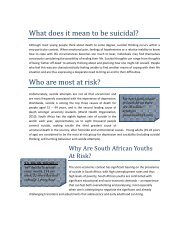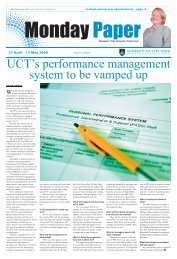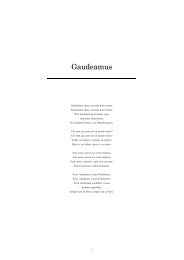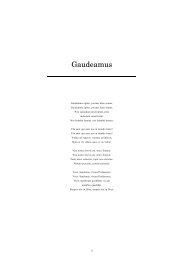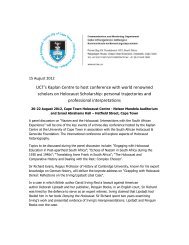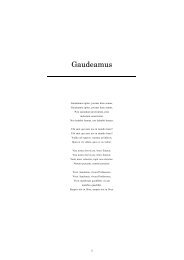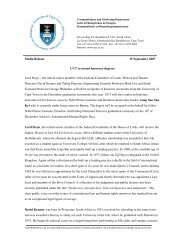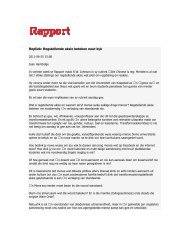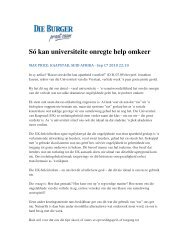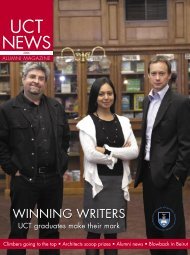uct heritage park management framework - University of Cape Town
uct heritage park management framework - University of Cape Town
uct heritage park management framework - University of Cape Town
You also want an ePaper? Increase the reach of your titles
YUMPU automatically turns print PDFs into web optimized ePapers that Google loves.
13<br />
2.3.6 Draft <strong>Cape</strong> <strong>Town</strong> Development Edge Policy, August 2009<br />
The draft <strong>Cape</strong> <strong>Town</strong> Development Edge Policy (August 2009) was developed in response to the<br />
existence <strong>of</strong> a plethora <strong>of</strong> documents and guidelines that had been adopted and used since 2001.<br />
The Urban Edge Policy for the City (adopted in 2001) comprised four geographically specific<br />
policies, the relevant one for this site being that for the “Peninsula”. This was supplemented by<br />
the Urban edge Guidelines Manual (approved in 2004). This incorporated Veldfire-Related<br />
Planning Guidelines that deal with the spread <strong>of</strong> fire on properties adjacent to the periphery <strong>of</strong><br />
the City, which is <strong>of</strong> particular relevance to the UCT Heritage Park.<br />
The Development Edge lines now reflected in the SDF and District SDPs & EMFs discussed below,<br />
will be approved as section 4(6) and 4(10) str<strong>uct</strong>ure plans respectively (in terms <strong>of</strong> the Land Use<br />
and Planning Ordinance, 1985) by the Provincial Government Western <strong>Cape</strong>. This implies that any<br />
amendment to the Urban Edge lines will have to follow the procedure for amending a 4(6)<br />
str<strong>uct</strong>ure plan.<br />
The Development Edge Policy states the following in relation to land use <strong>management</strong> <strong>of</strong> sites on<br />
the Urban Edge:<br />
“All development applications on the Urban Edge will need to be reviewed by the City in terms <strong>of</strong><br />
principles set out in the Urban Edge Guidelines Manual as well as the Veldfire Related Planning<br />
Guidelines Manual to be found as Annexure 6 in the Manual. The following are some <strong>of</strong> the<br />
relevant issues to bear in mind when first putting together proposals for sites on the urban edge:<br />
• Vacant and under-utilised land within existing urban areas should be serviced before that<br />
on the periphery;<br />
• Settlement forms on the periphery need to respect the landscape;<br />
• Low intensity land uses, that can facilitate the function <strong>of</strong> the area as a buffer in<br />
protecting agricultural and conservation land from the impacts <strong>of</strong> urban development<br />
needs, are more optimal than those that do not;<br />
• Continuation <strong>of</strong> open space systems related to riverine corridors, which can in turn<br />
facilitate connection between catchments and the coastlines, must be facilitated; and,<br />
• Establishment <strong>of</strong> public private partnerships for land use monitoring and services<br />
provision should be explored where possible.”<br />
The Guidelines Manual further sets out a number <strong>of</strong> specific considerations for planners to consider<br />
when assessing applications on sites adjacent to the Urban Edge Line. These serve as a useful guide<br />
for owners <strong>of</strong> land in the transition zone who wish to develop responsibly. They are as follows:<br />
• Are the proposals desirable from a public benefit and desirability perspective?<br />
• Do the proposals have cost implications for the City Council or society?<br />
• Is the site visually exposed?<br />
• Does the site contribute to the continuity and sustainability <strong>of</strong> aquatic or terrestrial<br />
ecological corridors?<br />
• Is the site adjacent to a protected or prod<strong>uct</strong>ive landscape?<br />
• Is the site in close proximity to a scenic route or in the vicinity <strong>of</strong> a landmark?<br />
• Is it close to a special place or significant urban/topographical element?<br />
• Is it in, or in close proximity to, the green str<strong>uct</strong>ure and are there potential fire hazards?<br />
UCT Heritage Park Management Framework: Final Draft Report, July 2012



